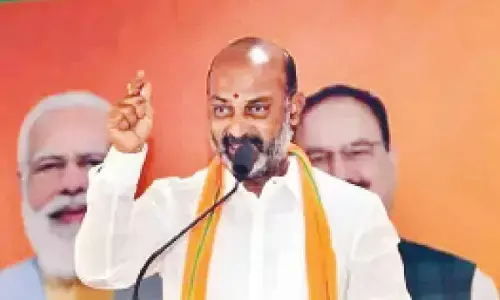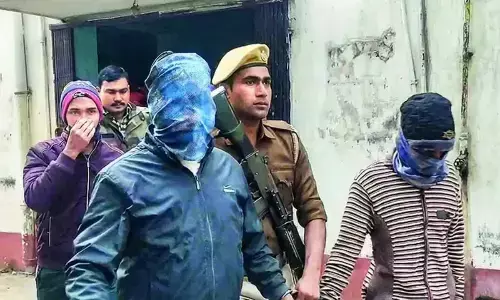No face-saver yet, post-DeMo

A year ago, Prime Minister Narendra Modi announced the scrapping of high-value bank notes which amounted to 86 per cent of the currency in circulation. The demonetisation of currency notes was said to be an attack on black money and counterfeit notes and a bold step to promote cashless transactions through digital mode.
A year ago, Prime Minister Narendra Modi announced the scrapping of high-value bank notes which amounted to 86 per cent of the currency in circulation. The demonetisation of currency notes was said to be an attack on black money and counterfeit notes and a bold step to promote cashless transactions through digital mode. A year later, now it is time to make a modest assessment of what this so-called historic move had achieved and whether this exercise was necessary to achieve the stated objectives of Modi to cleanse the economy of black money.
While Union Finance Minister Arun Jaitley calls the decision of November 8 a "watershed moment" in India's history, the Congress at the end of one year continues to stick to the stand it had taken in Rajya Sabha when the former Prime Minister Manmohan Singh called demonetisation as ‘tax terrorism.’ The Congress party is also using this tagline during its campaign for the Gujarat elections. The BJP has responded to Singh's ‘tax terrorism’ remark, questioning the Congress as to how a system that checks evasion is a fair and honest system.
Common man hit
Well, while the war of words would continue and may perhaps get shriller by the day as the polls approach, it is pertinent to note that life of the common man for a few months had become miserable due to acute shortage of liquid cash. It had in fact disrupted the life across the country for months together. The worst-affected were the people in rural areas as they do not have adequate access to banking and internet facilities. After a lot of trial and error method, the system of roving banking correspondents was introduced which provided some relief to the common man. More than 90 per cent of the rural areas in the country do not have access to a bank and less than 4 per cent of rural areas have internet connectivity. Even today there has not been much change in the situation as far as internet connectivity is concerned.
All these years, Indians whether in rural or urban areas have relied on cash for carrying out transactions. The sudden scrapping of currency notes had led to sharp decline in wholesale price index of many goods, particularly the perishable ones like fruits and vegetables, and the market suddenly turned into a buyers’ market. Even the rates of pulses had shown a downward trend. Also, the sales of two-wheelers and four-wheelers took a nosedive.
According to some experts, demonetisation resulted in the slowdown in the economy. Though economic slowdown had begun 15 months ago as revealed by the quarterly GDP numbers, the note ban has added fuel to the fire by bringing the growth levels further down. New project announcements declined sharply in the wake of demonetisation, hurting the capex cycle, analysts say, citing an analysis made by the Centre for Monitoring Indian Economy (CMIE)
Experts also opine that contrary to what some economists predicted, the dividend from RBI to the government was lower because of demonetisation. RBI’s domestic earnings declined as it had to pay interest of Rs 17,426 crore after it mopped up excess liquidity in the banking system following demonetisation. The previous year, the central bank had earned interest of Rs 506 crore in its liquidity management operations. RBI’s printing costs also went up because of the move.
Prime Minister Modi and Finance Minister Jaitley had stated that demonetisation would help in identifying and eliminating counterfeit notes. But that did not happen and even counterfeits of the freshly issued currency notes came into circulation. The Finance Minister had claimed that demonetisation would help in increasing the tax base. But the numbers reveal a different story. According to the finance Ministry’s estimates published in the recent Economic Survey, the tax base expansion attributable to demonetisation was a meagre Rs 10,600 crore, lower than what RBI spent on interest expenses. This clearly shows that the demonetisation exercise miserably failed on this front as well.
However, the bright side of the currency replacement is that it has led to a sharp increase in digital transactions. Even pan shops, roadside tea stalls and vegetable shops opted for digital payment modes like Paytm. There was also visible uptake in the use of debit and credit cards as well. According to the data released by the Reserve Bank of India, the value of transactions done through debit and credit cards at Point of Sales (PoS) as well as ATMs increased to Rs 26.22 lakh crore during the period from November 2016 to August 2017. There was a 16 per cent jump in the volume of transactions as well. The volume of transactions for both debt and credit card at PoS and ATM went up from 9,132 million in 10 months between November 2015 and August 2016 to 10, 612 million during November 2016-August 2017 period.
However, as re-monetisation increased, people started moving away from the digital modes and began re-embracing the cash. As a consequence, digital transactions have gradually come down. The other key aspect that is driving consumers away from digital payment space is the transaction cost that banks levy on each payment made using credit or debit cards.
At the same time, it has been noticed that concerted efforts made by the central and the state governments helped in greater penetration of digital payments during the last one year. The digital commerce appears to be reaping benefits from this increased penetration of digital payments even as consumers feel the pinch thanks to prevalent transaction charges.
Though the demonetisation has failed to achieve its stated objectives of eliminating black money, curbing counterfeit notes and plugging the fund flows to terrorists, the central government should use the increased adaption of digital payment modes during the note ban exercise to push India towards digital economy, to the extent possible.
That can only be achieved if the government makes efforts in reducing transaction costs. People in the developed world like Australia are shifting towards cash and a noticeable increase in the use of cash has been witness as people there are not happy with the charges on digital transactions.
Against this backdrop, it will be a Herculean task to push Indians towards digital economy if the banks force them to cough up charges for every digital transaction they make. Though some customers may not be aware, banks charge for NEFT, IMPS (immediate payment service), RTGS and what not. Even mobile wallets like PayTm collect service charges, and so do payment banks and UPI (unified payment interface), an instant payment facility rolled out by the National Payments Corporation of India (NPCI).
Transaction costs are, however, the highest on payments made through credit cards. If the government makes effort to minimise the financial burden on customers caused by these services, digital economy will grow. If that happens, the Modi government can showcase at least one benefit out of the botched demonetisation exercise.




















